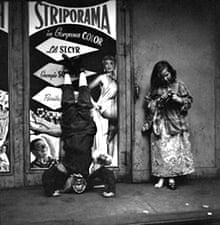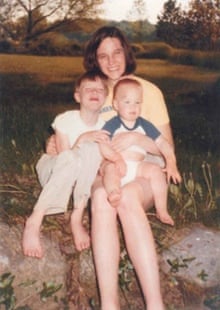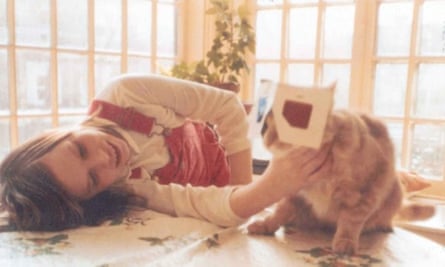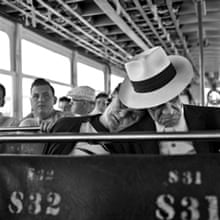 |
| Vivian Maier Self-Portrait, 1954 |
"Honestly, my reaction when this process started was, oh, they're doing a movie on my crazy nanny who I never really liked," says Joe Matthews. The nanny's name was Vivian Maier, and she looked after Joe, his sister Sarah and brother Clark in the Chicago suburbs for three years in the 1980s.
The family knew that Maier was unusual and that she took a lot of photographs. Her attic bedroom was kept locked and packed full of boxes and newspapers. Joe's mother, Linda, says that she hired Maier, who was in her 50s, because she wanted someone she could respect as an equal: "I liked Viv because she spoke her mind so I knew what I was dealing with. We could disagree. I could say, 'No, I don't like doing things that way.' I thought she made a good partner."
But neither Linda Matthews nor any of the other families Maier worked for dreamed that soon after her death in 2009, their former nanny would be hailed as a key figure in 20th-century American photography. "The first time I saw her picture on television, I was stunned," says Linda. "I knew she was talented but it's astonishing what she made of it. Who could have imagined she could have left so much behind?"

Maier left behind more than 100,000 images, in hundreds of boxes of negatives and undeveloped rolls of film, as well as some Super 8 home movie footage, audio tapes and trunks full of memorabilia. Some of this was auctioned when Maier, who had fallen on hard times, could no longer keep up payments on a storage locker. One of the buyers was an estate agent and flea-market enthusiast called John Maloof. When he began to print the black-and-white street portraits that were her speciality, he was captivated. Vivian Maier's life and photography became his passion and, eventually, his living.
It was years before Maloof could attract interest in Maier's work. The first time he searched for her name on the internet he found nothing and it was only by chance that when he tried again in 2009 he found a brief obituary. Spurred on by the warm response to a photography blog he put together, he began writing to museums and, when these approaches were rejected, put on his own exhibition. Now he has made a film, Finding Vivian Maier, which pieces together her life story and makes a case, heartfelt if not disinterested (as Maloof owns the copyright), for her as an artist of comparable importance to great names of 20th-century American photography such as Diane Arbus, Robert Frank and Weegee.
Maier shot glamorous women shopping and dramatically lit buildings. A letter found among her possessions suggests that she may on occasion have worked for a newspaper. But most of the celebrated images that now sell for thousands and hang on gallery walls depict people on the powerless fringes of society: African Americans, children, the old and the poor.
Her camera, a Rolleiflex, was operated at chest level, which allowed the photographer to maintain eye contact with the person whose picture she was taking. Many of her strongest and most memorable shots are of people staring straight at her.
So what was it like to be looked after by this remarkable character who described herself as a "mystery woman" and "sort of a spy"? Joe Matthews and Sarah Ludington, six and nine respectively when Maier arrived, and their mother, Linda, share their memories of Maier in three conversations that are intriguing for the different lights they throw on her.
"As an adult I would say she was a person who had a lot of baggage, literally and figuratively," says Joe. "It was so bizarre. I went into the attic maybe three times the whole time she was my nanny and the stacks of newspapers were taller than me. It was like walking through a valley of newspapers."
His sister got more out of the long city walks on which Maier took them after school, with their baby brother, Clark. "I was a solitary child and didn't have many friends, so the time I spent with Viv was what I had to do," Sarah says. "I liked the walks. By the end, I would be in pain. We were walking probably 10 miles which when you're little is a long way, but often she would take us to the beach at the end."
The children knew that the main purpose of these outings was not for their benefit but to take pictures. "Many of her subjects I recognise," Sarah says. "The one that sticks in my head is the picture she took of a man whose face was burned off, whom we often saw. I remember seeing him as a child and wondering if I should look or not. I remember thinking about that. She truly did look at people in a different way and was not afraid to look."

"I don't think she liked kids at all really," says Joe. "I think she liked images. When she saw an image she had to capture it. I think it was the same compulsive behaviour that made her hoard newspapers. My brother probably got on best with her. He was so little and has always been a good-natured boy. I was the trouble-maker, testing and teasing her. I always got the feeling that what she wanted to do was take photos and hauling the kids around was just a chore."
In the film, Linda Matthews is tearful when describing Maier's departure: Vivian, known to the family as Viv, came home one day to find that a pile of her newspapers was missing. She lost her temper with Linda and the neighbour who had taken the papers to cover the floor while redecorating.
Linda sacked her. "I felt very bad about it, I thought maybe we would stick together for a few more years but my husband also felt we were at the point where we had to do something," she says. "You can't forget this is someone's livelihood and I didn't dismiss her lightly but there was an accumulation of small things. She let the children wander off so they got lost. There was nothing I could do to keep them from growing up and I could see they were having a harder time."

Born in New York in 1926, Maier spent much of her childhood in the French Alps before returning to the US and working in a sweatshop before starting up as a nanny. In 1960, she travelled to Asia but, apart from this trip, remarkable for a single woman of her background at that time, she mostly lived for 40 years with the families she worked for in Highland Park, Chicago.
Maloof and his co-director, Charlie Siskel, interview several of these families in their film. Several times interviewees contradict each other: she was Miss Maier, Miss Meyer, Vivian or Viv. She was great with kids, or harsh and uninterested. She was secretive, had no desire for publicity, or frustrated by her situation. She was mentally ill, ruled by an impulse to collect or a smart talker with strong political views and a sense of humour.
Siskel thinks the role of nanny may have suited her in some respects, sharpening her perspective as an observer. But he was troubled by the testimony included in the film of Inger Raymond, who describes Miss Maier as her governess from the age of five to 11.
Among more unpleasant memories, Raymond recalls Maier force-feeding her: "She would hold me down, she would shove the food in and she would choke me until I swallowed – and she would do that over and over again." She also describes having her head banged against a bookcase, while Joe Matthews says his brother's only memory of their nanny is of being spanked for spilling a glass of milk.
Such outbursts, combined with her isolation, estrangement from her family and what he perceived as hostility to men, make Joe Matthews suspect some trauma in Maier's own past and possibly abuse.

It is sad as well as perplexing that the woman who had such a knack for capturing human moods and expressions in her photographs, and showed such tenacity and originality in making her work, should have passed her whole life without forming intimate relationships of her own. In her last years she was a pitiful figure, often seen on a bench in a park, eating corned beef hash from a can.
One day in 2006, by now married and a mother herself, Sarah Ludington bumped into Maier in a fabric store, "I walked up to her and said 'Hello, Viv!' which I never would have done as a child. She told me she was looking for a job and asked if I would hire her to take care of my babies."
Ludington's reaction was shock – not at the proposal from a woman of 80, but, "I realised that after all these years maybe I would consider it. With so many difficult and unusual creative people there are trade-offs. But she did what she thought was important. She offered me a lot and I guess in the end I'm not surprised that she had more up her sleeve."

No comments:
Post a Comment